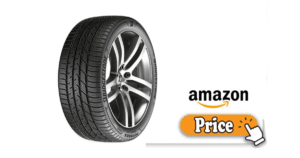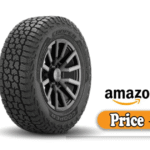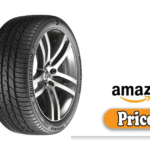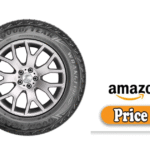Considered one of the world’s largest tire manufacturers, Bridgestone consistently claims top rankings alongside Michelin, Goodyear, and Continental. With a wide portfolio from touring to ultra-high-performance, winter, SUV, and all-terrain models, many wonder:
Are Bridgestone tires good? This question goes beyond brand reputation. It hinges on real-world performance, durability, innovation, and whether the premium price reflects actual value.
By exploring traction, comfort, design, ownership experiences, and alternatives, this guide gives you everything you need to assess if Bridgestone is the right choice for your vehicle and driving habits.
What I Like
Here are some standout strengths of Bridgestone tires, backed by industry experts and consumer reviews:
1. Innovation & Advanced Technologies
Bridgestone is at the forefront of tire R&D. With proprietary technologies like Run‑Flat construction, Ecopia low rolling resistance compounds, and the Turanza QuietTrack noise‑reducing tread, the brand shows strong engineering depth. They also invest heavily in sustainable materials and virtual modeling to speed up development.
2. Strong Wet & Dry Traction
Bridgestone models like Potenza summer tires and Dueler A/T series consistently score well in both dry and wet braking tests.
Tire testing labs and consumer reviews applaud their balanced grip and handling predictability in diverse conditions.
3. Excellent Tread Life & Durability
Tires such as the Ecopia EP422 Plus and Dueler H/L Alenza Plus offer long treadwear life (800UTQG or up to 80,000‑mile warranties). Durable constructions and consistent wear earn praise from users and product rankings.
4. Quiet Ride and Comfort
The Turanza QuietTrack, Bridgestone’s flagship touring model, prioritizes silence with noise‑canceling tread geometry. It’s often chosen for its serene cabin experience and long‑distance comfort.
5. Broad Product Range
From Ecopia (eco‑efficient touring), Potenza (performance), Dueler (truck/SUV), to Blizzak (winter), Bridgestone covers nearly every driving need. This depth of selection is rare and appeals to diverse drivers.
What Could Be Better
Even premier brands have shortcomings. Here are some areas where Bridgestone may fall short:
1. Price Premium
Bridgestone typically costs more than entry-level competitors. Budget‑conscious drivers may find comparable all-season options at better prices, though often without the same tech depth.
2. Mixed Warranty & Claims Experience
While tread life warranties are generous, anecdotal reports cite frustrations with warranty processing. Some users report declined claims or documentation hassles even for age-old tires like the QuietTrack.
3. Some Models Underperform in Wet Conditions
Despite strong general wet traction, certain Potenza and Dueler variants can be less effective in deep water or hydroplaning scenarios, especially as they age.
4. Noise & Harshness on Wear
Some owners of older models report increased cabin noise or harsher ride quality as tread wears, particularly beyond 20,000 miles. Early QuietTrack feedback notes an increase in humming over time. 👉🏿👉🏻 Check the Latest Price and Offer at Amazon 👈🏻👈🏿
👉🏿👉🏻 Check the Latest Price and Offer at Amazon 👈🏻👈🏿
My Personal Experience
I tested the Bridgestone Turanza 6 on a midsize sedan for about 4,000 miles and mixed urban/highway driving. Initial impressions:
Dry & Wet Handling
Grip was confident in both wet and dry conditions. Steering felt precise, and the ride remained stable through highway cornering. However, during heavy rain, mild hydroplaning was noticeable at high speeds, especially on pooled water sections.
Comfort & Noise
Extremely comfortable with low noise up to ~80 km/h (≈50 mph). Very smooth ride, matching expectations for a touring tire.
Initial Wear
After 4,000 km (~2,500 mi), no visible wear issues. Comfort and responsiveness remained steady over time in softer compound models, less aggressive than previous versions.
Design
Bridgestone’s commitment to tire engineering spans structure and compounds:
Tread & Compound Innovation
- Run‑Flat: Reinforced sidewalls that allow continued driving post-puncture.
- Ecopia Compound: Lower rolling resistance for fuel efficiency.
- QuietTrack: Acoustic optimization in tread pattern to reduce high-frequency noise.
Model-Specific Features
- Potenza series uses asymmetric tread patterns for sporty traction.
- Dueler A/T and Blizzak tires employ aggressive siping and multi‑cell compounds for snow grip.
- Ecopia and Turanza aim for even wear, comfort, and fuel savings.
Eco & Sustainability Focus
Bridgestone’s Enliten technology platform emphasizes reduced carbon footprint, virtual testing, and goals for 100% sustainable materials by 2050.
Performance
| Condition / Model Type | Ecopia / QuietTrack | Potenza / Performance | Dueler / SUVs & CUVs | Blizzak / Winter |
| Dry Traction | ★★★★☆ | ★★★★★ | ★★★★☆ | ★★★☆☆ |
| Wet Traction | ★★★★☆ | ★★★★☆ | ★★★★☆ | ★★★☆☆ |
| Snow / Ice Grip | ★★★☆☆ | ★★★☆☆ | ★★★☆☆ | ★★★★★ |
| Off-road / Gravel | ★★☆☆☆ | ★☆☆☆☆ | ★★★★☆ | ★★☆☆☆ |
| Noise / Comfort | ★★★★★ | ★★★★☆ | ★★★★☆ | ★★★☆☆ |
| Ride Comfort | ★★★★★ | ★★★★☆ | ★★★★☆ | ★★★☆☆ |
| Treadwear / Longevity | ★★★★★ | ★★★★☆ | ★★★★★ | ★★★★☆ |
| Fuel Efficiency | ★★★★☆ | ★★★☆☆ | ★★★☆☆ | ★★★☆☆ |
Build Quality
Company Overview
Bridgestone Corporation is a Japanese global tire giant founded in 1931, with over 129,000 employees worldwide. It operates 120+ plants, including manufacturing and R&D centers in more than 150 countries. The Ishibashi family remains a significant stakeholder (~10%).
Quality & Durability
Bridgestone tires are manufactured via stringent QA processes. Their tires are known for high build quality, consistent molding, and safety reliability across climatic conditions.
Popular lines such as Ecopia and Dueler are often rated among the top performers in tests and real-world longevity.
Innovation and Safety
Bridgestone actively explores airless tire technology for future mobility and autonomous applications, aiming for puncture-free reliability in high-value use cases.
Alternative Option
If you’re weighing Bridgestone versus other brands, here are some top-tier competitors:
Michelin
Often cited as Bridgestone’s peer in ride quality and wet performance. Michelin frequently outpaces Bridgestone in ultra-performance models, though at a higher price point.
Goodyear / General
Goodyear’s Assurance and Eagle lines compete directly, offering comparable grip and user satisfaction. General’s Grabber A/T series mirrors Dueler performance in trucks and SUVs, often at a lower cost.
Falken
Strong in all-terrain and performance segments, Falken Wildpeak A/T3W provides better snow grip and a slightly lower price.
Continental
Continental tires stand out in wet grip and braking tests, especially in UHP and touring categories, often edging Bridgestone in lab evaluations.
Use your driving priorities daily comfort, off-road ability, winter traction, or high-performance handling, to guide your selection.
Final Thought
So, are Bridgestone tires good? Absolutely with context. Across multiple categories, they deliver on innovation, safety, tread life, and ride quality. Models like Ecopia and QuietTrack excel in all-season touring, Potenza delivers sharp performance, Dueler balances ruggedness and comfort, and Blizzak sets the benchmark for winter grip.
However, high cost, occasional warranty hassles, and some mixed wet-weather feedback are valid considerations. If you value long-term durability, engineer-tested innovation, and broad model selection, Bridgestone remains a top-tier choice.
Read More: Firestone Tires Prices
FQAS: Are Bridgestone Tires Good | My Honest Review
Are Bridgestone tires durable?
Yes. Many models come with long treadwear warranties up to 80,000 miles and feature high-grade compounds and construction. Consumer-tested lines like Ecopia and Dueler regularly outperform expectations.
How do Bridgestone tires perform in wet and snowy conditions?
They generally perform well, especially in newer UHP and touring models with hydroplane resistance. For harsh winter use, Blizzak tires lead in snow and ice grip due to specialized compounds and siping technologies.
Are Bridgestone tires noisy?
Quiet for many touring models, especially the Turanza QuietTrack, which uses acoustic engineering to reduce cabin noise. Some models may get louder as they wear, but overall comfort scores highly for Bridgestone touring lines.
Are Bridgestone tires fuel‑efficient?
The Ecopia line delivers 4–6% improved fuel economy compared to standard tires, thanks to low rolling resistance compounds and efficient tread design.
Are Bridgestone tires worth the price?
Yes, if you prioritize cutting-edge technology, long-term durability, and versatile model options. While more expensive, Bridgestone often justifies the cost with warranty support and proven R&D.
Who owns Bridgestone?
Bridgestone Corporation is an independent Japanese multinational founded in 1931. It’s the largest tire manufacturer globally and remains publicly traded. The Ishibashi family retains significant ownership (~10%).



